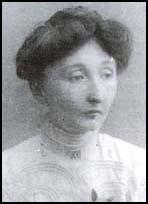Aeta Lamb

Aeta Lamb was born in Demerara in 1886. Her father was a botanist and he named her after a palm he had discovered there. On the death of her father in 1891 the family returned to England. She attended Notting Hill High School between 1898-1899.
In 1906 Lamb joined the Women Social & Political Union (WSPU). Her biographer, Vera Douie has argued that: "Being absolutely sexless herself - men for her did not exist - they really did not count. That they were there to do a certain amount of necessary work in the world she admitted but she mostly saw them as oppressors of women."
Lamb spent some time at the WSPU headquarters in London. Sylvia Pankhurst described her as "flitting about like a disembodied spirit; for her paleness and shyness seldom appreciated at her worth." A fellow member commented: "Her hair was really beautiful and fell in long silky waves to her waist but she would insist on screwing it into a horrid little knob on the top of her head." According to Mary Leigh, Lamb was responsible for writing speeches for Christabel Pankhurst.
In October 1906 Lamb was arrested in a demonstration outside the House of Commons. Later she recalled that it was "a terrible ordeal being ridden down by mounted police." She was released after her mother paid her fine. In February 1907 Lamb was arrested at another demonstration and was sentenced to a week in Holloway Prison. Within a few days of her release she was arrested again and this time served four weeks in prison.
In 1908 Lamb joined Annie Kenney, Mary Blathwayt, Clara Codd and Elsie Howey in the West of England campaign. Soon afterwards she was appointed as WSPU in Bristol. In her diary, Emily Blathwayt claimed that for one meeting in April 1908 she "hired six professional boxers to keep order." Lamb also helped Mary Gawthorpe in the Kincardineshire by-election. She followed this with the by-election in Dundee and Pudsey. After this she was based at the WSPU headquarters in London.
Lamb became a regular visitor to Eagle House near Batheaston, the home of fellow WSPU member, Mary Blathwayt. Her father, Colonel Linley Blathwayt was sympathetic to the WSPU cause and he built a summer-house in the grounds of the estate that was called the "Suffragette Rest". On 16th April 1911 Colonel Blathwayt planted a tree, a Texas Baccata Fastigiata, in her honour in his suffragette arboretum in a field adjacent to the house. Emily Blathwayt recorded in her diary that "people like Miss Lamb do not at all like Mrs. Pankhurst's present policy." B. M. Willmott Dobbie the author of A Nest of Suffragettes in Somerset (1979) claims that "frail, timid and nervous, her stamina proved unequal to her enthusiasm, and she withdrew from active participation."
According to Elizabeth Crawford, the author of The Suffragette Movement (1999), during the First World War "she worked in War Depots and afterwards found it very difficult to find work." Vera Douie points out that although she learned shorthand and typing, "her low vitality and her inability to adapt herself to new places and uncongenial people proved great obstacles in her way."
Aeta Lamb died of cancer in the New Hospital for Women in 1928.
Primary Sources
(1) Emily Blathwayt, diary entry (3rd November, 1912)
Aeta Lamb planted her new tree. The first suffragette to come to this house and now probably the last to plant a tree.
(2) Emily Blathwayt, diary entry (6th November, 1912)
Mary in Bath all day working for the Pankhurst cause - we wish she was not, but the young people all do this kind of thing now and I suppose it is evolution. The oldest supporters are fast leaving the WSPU, especially those old in years, but people like Miss Lamb do not at all like Mrs. Pankhurst's present policy.
